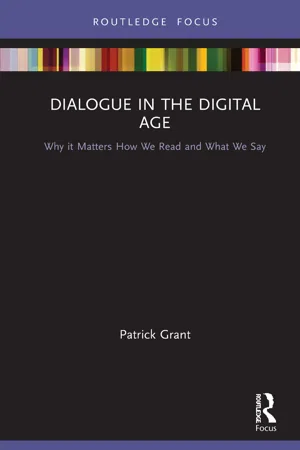A climate of the times
Ironically, in the present cultural phase the atomizing of individuals and the depersonalizing mechanisms that bring it about are greatly heightened by the communication technologies so remarkably developed by the digital revolution. Cell phones, text messages, Facebook, Twitter, Instagram, emails, and the World Wide Web enable a hyper-communication that all too often turns out to be barely communication at all. One problem is simply that tsunamis of information without context have a fragmenting effect that makes it difficult to develop any patiently consolidated store of personal knowledge from which coherent discourse can be shaped. Even for the many people who bring to bear a developed critical perspective, the task of sifting through the sheer volume of information (and misinformation) is prohibitively taxing and time consuming. Consequently, it is not hard to notice today how a widespread skepticism about public discourse is accompanied by a privileging of emotion over reason – the Like button, as it were – accompanied by a readiness to disregard evidence and reasoned argument. It is hardly surprising that a recent RAND report describes a steady “truth decay” in journalism in the United States during the past three decades as news coverage has shifted increasingly “to opinion-based content that appeals to emotion”, while “extreme sources play on people’s worst instincts, like fear and tribalism”.3 In addition, a rapid increase in mass surveillance, the widespread political and commercial deployment of algorithms developed by Big Data, the use of “persuasive design” technologies, and targeted advertising are producing the exact opposite of the individual self-determination and freedom that these various thriving enterprises claim to champion.
To make matters more challenging, literacy rates in the United States and Canada today are a cause for serious concern. In the United States, almost one third of the population is “illiterate or barely literate”, and approximately 50 percent of adults “can’t read a book written at eighth-grade level”. In Canada, some 43 percent of adults have low literacy skills – that is, “too low to be fully competent in most jobs in our modern economy”. A report from the Organization for Economic Cooperation and Development (2012) assessed literacy among 16- to 19-year-olds in 23 countries. The United Kingdom was in 23rd place, the United States 21st, and Canada 17th.4 Maryanne Wolf, who writes well about the effects of digital technology on children’s learning, reports that “a full two-thirds of U.S. children in the fourth grade do not read at a ‘proficient’ level”. She presents evidence that children who are allowed a lot of screen time do not read, analyze, or comprehend as well as children whose screen time is restricted. Although good reading skills are necessary to “maintain the intellectual, social, and economic health of our country”, at the moment “two-thirds or more of future U.S. citizens are not even close”.5 Wolf does not recommend trying, somehow, to turn back the clock. Rather, we should focus on developing biliterate skills, so that the patient work of learning to read, think, and communicate is not neglected, even as more of people’s time is taken up by the different kind of attention cultivated by digital communication.
In view of all this, my main point is simple enough: the domain of the abbreviated text message, the Facebook outrage, the 140-character public-policy statement, together with the general, enervating confusion caused by information overload and what the TV commentator Van Jones felicitously calls “cancel culture; call-out culture”6 (by which he means, I take it, the fashionable strategy of immediate hostile rejection of a dissenting point of view followed immediately by accusation), is not at all what I take dialogue to be. Also, although these indicators of malaise are specific to the present times, it is worth noticing that they reproduce – even as they intensify – the basic alienations caused by a system that from the start has fetishized self-interest and individualism at the expense of the personal. Here, I take “personal” in a quite traditional sense to indicate a way of understanding human beings and the cultural and political means by which they organize their common life. That is, individuals are said to enter into personhood through relationship, entailing a recognition in the other of a sentience and intentionality akin to one’s own, together with a shared sense of strangeness, or difference. Because the personal develops always from and through the interpersonal, it follows that in the social sphere the good of all is returned as the good of each, so that the realization of communal goals is also the self-creation of those agents, or persons, who bring them about.7 The analogue of this process in the realm of verbal discourse is what I mean by dialogue.
